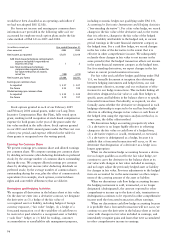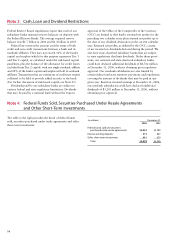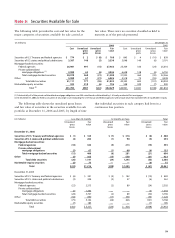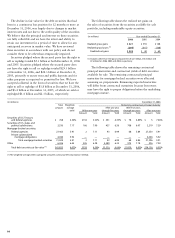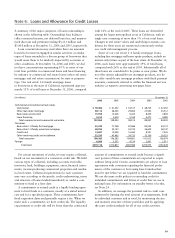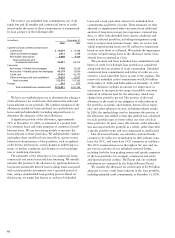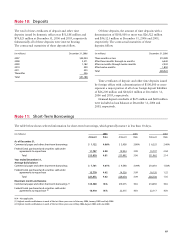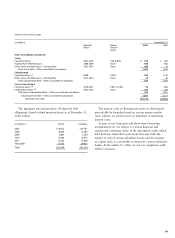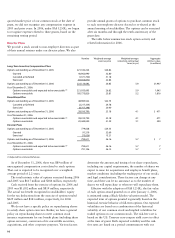Wells Fargo 2006 Annual Report Download - page 84
Download and view the complete annual report
Please find page 84 of the 2006 Wells Fargo annual report below. You can navigate through the pages in the report by either clicking on the pages listed below, or by using the keyword search tool below to find specific information within the annual report.
82
(in millions) December 31,
2006 2005
Commercial and commercial real estate:
Commercial $ 79,879 $ 71,548
Other real estate mortgage 2,612 2,398
Real estate construction 9,600 9,369
Total commercial and
commercial real estate 92,091 83,315
Consumer:
Real estate 1-4 family first mortgage 9,708 10,229
Real estate 1-4 family junior lien mortgage 44,179 37,909
Credit card 55,010 45,270
Other revolving credit and installment 14,679 13,957
Total consumer 123,576 107,365
Foreign 824 675
Total unfunded loan commitments $216,491 $191,355
The total of our unfunded loan commitments, net of all
funds lent and all standby and commercial letters of credit
issued under the terms of these commitments, is summarized
by loan category in the following table:
We have an established process to determine the adequacy
of the allowance for credit losses that assesses the risks and
losses inherent in our portfolio. We combine estimates of the
allowances needed for loans analyzed on a pooled basis and
loans analyzed individually (including impaired loans) to
determine the adequacy of the total allowance.
A significant portion of the allowance, approximately
70% at December 31, 2006, is estimated at a pooled level
for consumer loans and some segments of commercial small
business loans. We use forecasting models to measure the
losses inherent in these portfolios. We independently validate
and update these models at least annually to capture recent
behavioral characteristics of the portfolios, such as updated
credit bureau information, actual changes in underlying eco-
nomic or market conditions and changes in our loss mitiga-
tion or marketing strategies.
The remainder of the allowance is for commercial loans,
commercial real estate loans and lease financing. We initially
estimate this portion of the allowance by applying historical
loss factors statistically derived from tracking losses associated
with actual portfolio movements over a specified period of
time, using a standardized loan grading process. Based on
this process, we assign loss factors to each pool of graded
loans and a loan equivalent amount for unfunded loan
commitments and letters of credit. These estimates are then
adjusted or supplemented where necessary from additional
analysis of long-term average loss experience, external loss
data, or other risks identified from current conditions and
trends in selected portfolios, including management's judg-
ment for imprecision and uncertainty. Also, we review indi-
vidual nonperforming loans over $3 million for impairment
based on cash flows or collateral. We include the impairment
on these nonperforming loans in the allowance unless it has
already been recognized as a loss.
The potential risk from unfunded loan commitments and
letters of credit for wholesale loan portfolios is considered
along with the loss analysis of loans outstanding. Unfunded
commercial loan commitments and letters of credit are con-
verted to a loan equivalent factor as part of the analysis. The
reserve for unfunded credit commitments was $200 million
at December 31, 2006, and $186 million at December 31, 2005.
The allowance includes an amount for imprecision or
uncertainty to incorporate the range of probable outcomes
inherent in estimates used for the allowance, which may
change from period to period. This portion of the total
allowance is the result of our judgment of risks inherent in
the portfolio, economic uncertainties, historical loss experi-
ence and other subjective factors, including industry trends.
In 2006, the methodology used to determine this portion of
the allowance was refined so that this method was calculated
for each portfolio type to better reflect our view of risk in
these portfolios. In prior years, this element of the allowance
was associated with the portfolio as a whole, rather than with
a specific portfolio type, and was categorized as unallocated.
Like all national banks, our subsidiary national banks
continue to be subject to examination by their primary regu-
lator, the OCC, and some have OCC examiners in residence.
The OCC examinations occur throughout the year and tar-
get various activities of our subsidiary national banks,
including both the loan grading system and specific segments
of the loan portfolio (for example, commercial real estate
and shared national credits). The Parent and our nonbank
subsidiaries are examined by the Federal Reserve Board.
We consider the allowance for credit losses of $3.96 billion
adequate to cover credit losses inherent in the loan portfolio,
including unfunded credit commitments, at December 31, 2006.






